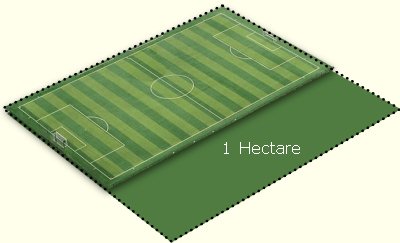My American readers are probably scratching their heads. They want to know: What the heck’s a hectare?
It’s the kind of question you’d expect from people who still cling to their old measurements: inches instead of centimeters, feet instead of meters, and miles instead of kilometers.
Yes, hectares are a part of the metric system–i.e., the system of measurement that just about every country in the world uses except for the United States. Only two other nations are metric deniers: Liberia and Myanmar.
Yes, I’m hectoring you over hectares.
I kid–and I kid without malice because the United States is an exceptional country. Americans are wonderful people. And there’s nothing wrong with measuring things the way you do.
Here in Australia, we converted to metrics in 1966. I still remember when it happened. I grew up in a pre-metric world and retain a certain fondness for the old ways of doing things, whether it’s sizing up fields in acres or weighing material in the avoirdupois system, with its tons, hundredweights, quarters, pounds, and ounces.
Call me multilingual in measures.
Even so, I’ve converted to metrics. There’s something to be said for their elegant uniformity. For farmland, our basic unit of measurement is the hectare. One hectare equals exactly 10,000 square meters. That’s a nice, round number. It’s easy to calculate and remember.
Do you even know how many square feet are in an acre? The answer is 43,560. Perhaps this is because 43560 is the zip code for the town of Sylvania, Ohio. That’s about how much sense it makes to us now that we are converted.
Five years ago, Truth About Trade and Technology (TATT) announced and celebrated a significant global achievement: A farmer planted the world’s one-billionth acre of GM crops. In other words, land devoted to GM crops had filled up 43,560 square feet for the one-billionth time.
Nobody knows the identity of this path-breaking farmer. It could have been a corn grower in Iowa or cotton raiser in India. Whatever the specifics, a careful review of international agriculture statistics revealed that the year 2005 saw the cumulative total area of biotech crops sprint across the one-billion acre mark.
This was an amazing accomplishment. Just a decade after biotech’s commercialization, farmers were so eager to benefit from genetic enhancement that they had planted and harvested more than a billion acres of these crops.
For all the fanfare, this celebration of acreage struck many farmers outside the United States as a little odd because we insist on counting in hectares. There are about 2.47 acres in a hectare, so a billion acres comes out to nearly 405 million hectares–a big number, not as momentous as a billion.
Now it’s 2010 and we’ve finally caught up. Users of the metric system have their own milestone to commemorate. According to TATT’s biotech counter, GM crop plantings passed the one-billion hectare mark a few weeks ago. Before the year is over, GM crop harvests will pass the one-billion hectare mark as well.
These different milestones point to the same basic truth: Biotech crops make sense because they improve production and protect the environment. I’ve seen it on my own farm in GM cotton and many Australian farmers have seen it on theirs in GM canola. We’re looking forward to the day when GM traits come to wheat as well.
When GM acreage hit the one-billion milestone, several commentators made the point that biotechnology had become so common in agriculture that it was the “new conventional”–i.e., it had gone from cutting-edge to ordinary.
This claim holds even more truth today. After all, one billion hectares is a huge area by any standard of measurement. It’s a little larger than the entire United States, including Alaska.
That’s a heck of a lot of GM crops. You might even say a hectare of a lot.
Jeff Bidstrup and his family grow cotton, wheat, sorghum and chickpeas in Queensland, Australia. Jeff served as the national convenor of the Producers Forum, an organization of farmers whose vision is to ensure timely access to agricultural biotechnologies for the economic, social and environmental benefits of all Australians. Mr. Bidstrup is a member of the Truth About Trade & Technology Global Farmer Network and the 2008 recipient of the Kleckner Trade and Technology Advancement award.

